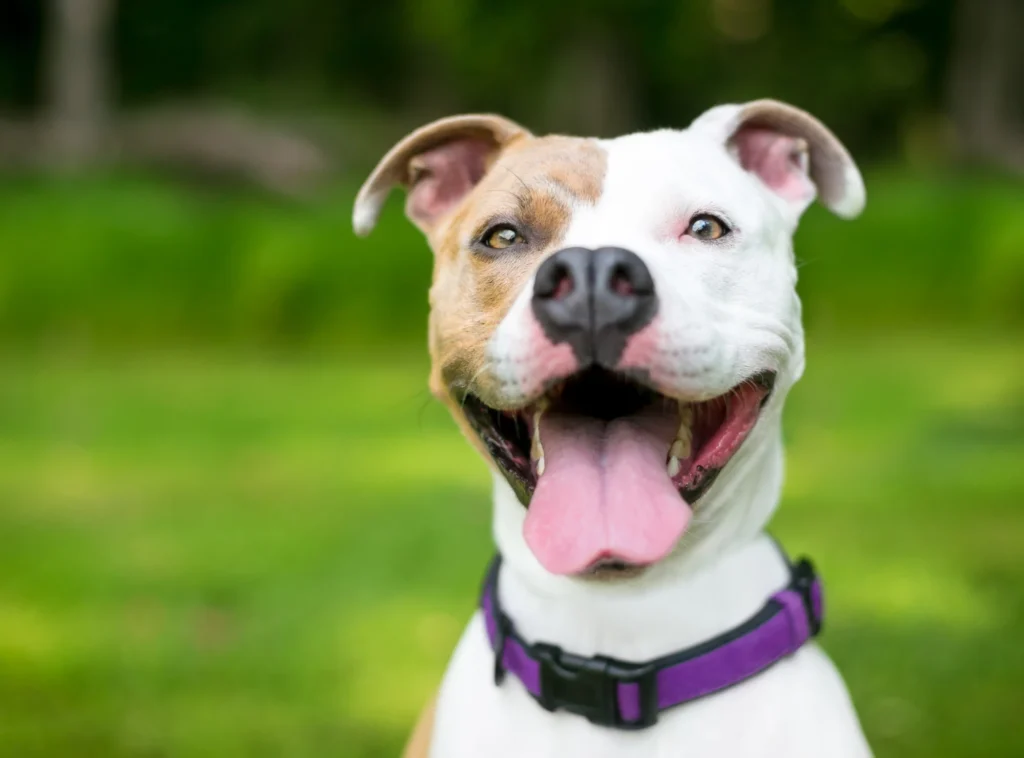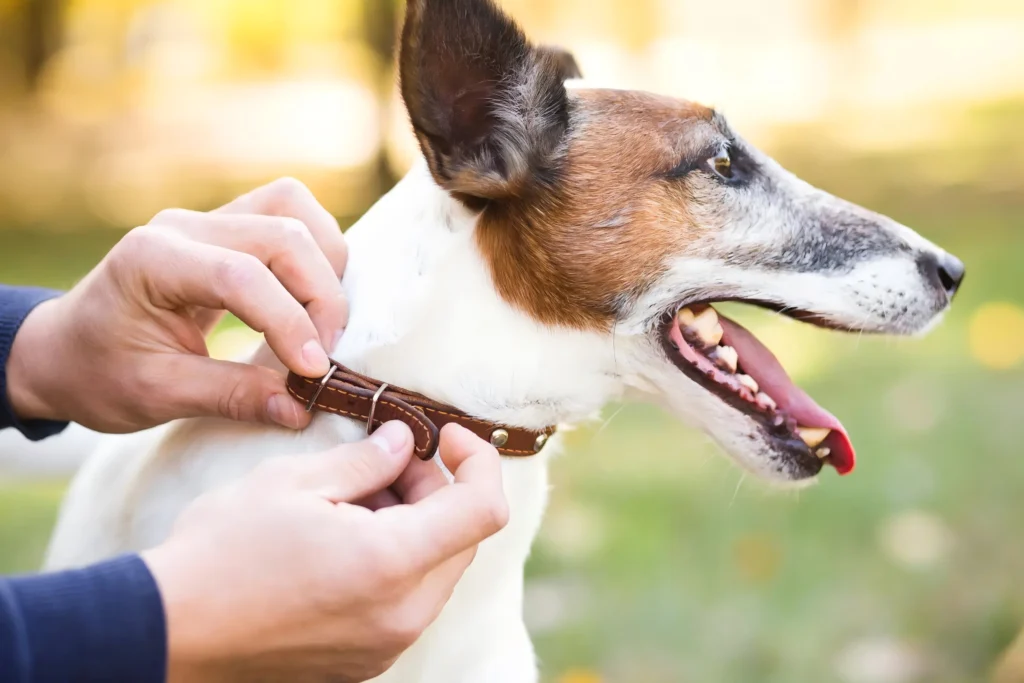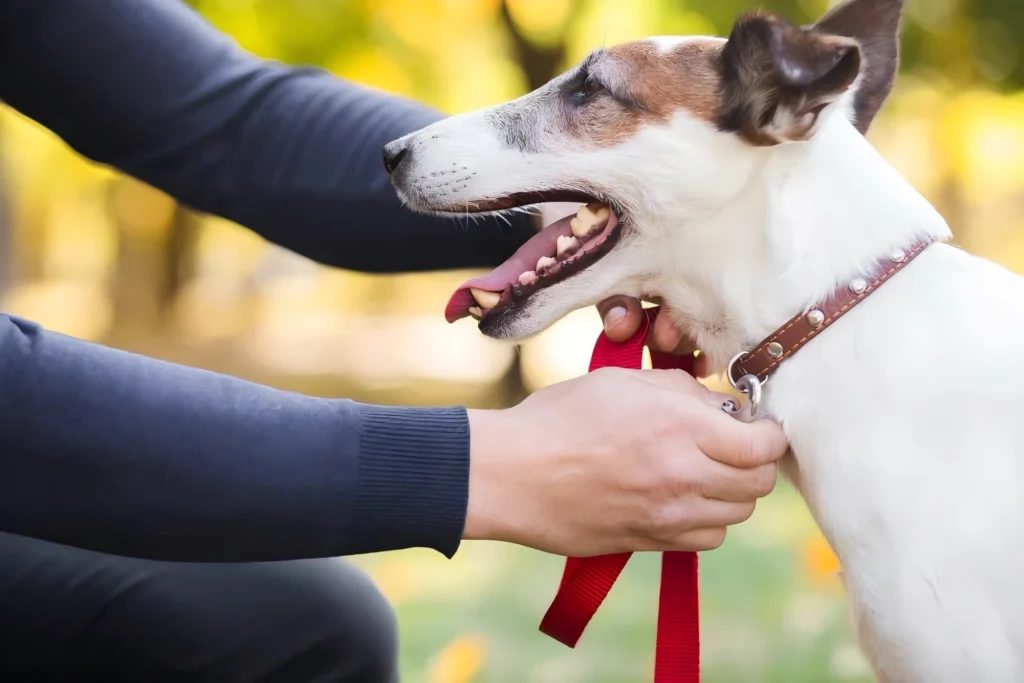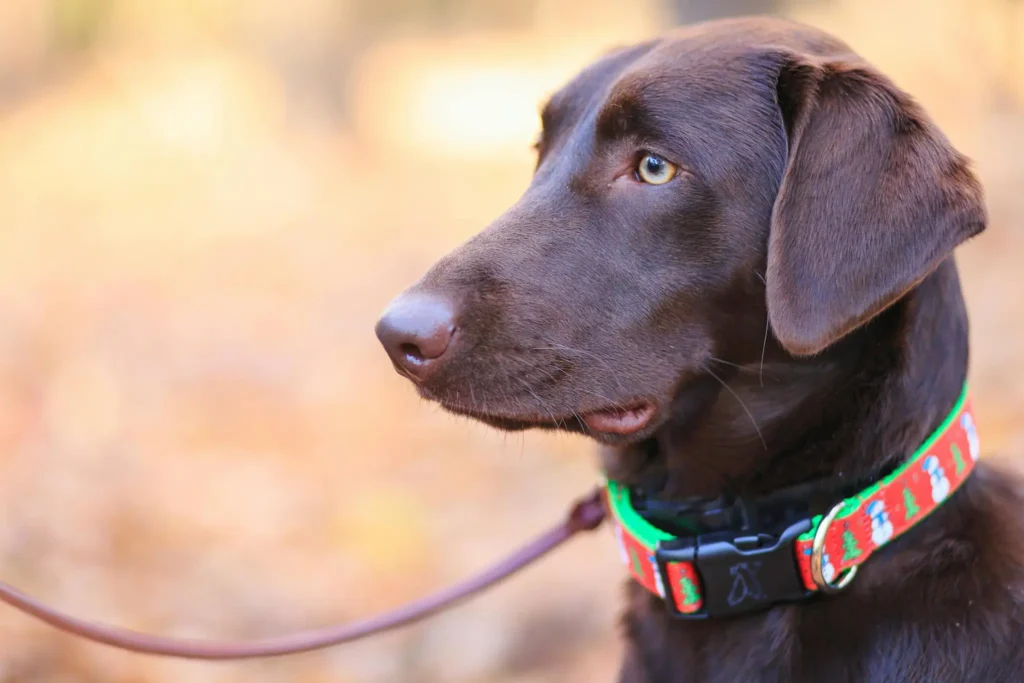How Tight Should A Dog Collar Be?

How tight a dog collar should be is an important question that stems from the need to ensure dog safety. A customized dog collar has become an essential piece that symbolizes identification and a control measure that allows you to attach a leash to your dog. Dog collars come in different varieties, such as buckle dog collars, dog harnesses, and slip collars. These varieties are made in various sizes ranging from the 0.56-inch extra small collar to the twenty-four to thirty-inch extra large dog collar.
However, the mass adoption of customized dog collars for dog lovers has brought about a problem of misjudgment and error in the calculation when choosing the suitable customized collar for their dogs. Some people end up picking too-tight collars that end up strangling and causing discomfort for their dogs, while others select a loose collar that poses an escape risk. This article aims to reduce these errors by explaining the specifics of achieving the perfect fit for your dog collar.
Table of Contents
ToggleUnderstanding the Ideal Dog Collar Fit
There’s no better feeling than getting a suitable collar fit for your dog. The reason for this stems from the advantages that surround this concept. The simplest method to get the ideal collar fit for your dog is by measuring the circumferences of your dog’s neck with a tape rule and adding about two to three inches to the measurement to get the correct tightness of your dog collar. There should also be a consideration for the safety and comfort of the collar on your dog’s neck.
The best way to go about this is the two-finger rule. This method states that your dog collar should be tight enough to stay in place while being loose enough to slip two fingers underneath the collar. In essence, this method ensures your dog’s security, freedom, and comfort.
Safety in the context of getting the ideal dog collar is essential because a loosely fitted collar and leash are prone to slipping off, which might put your dog at risk of injury or straying away. Comfort for your dog is important when getting a suitable collar fit. Dog skin is made up of sensitive layers that are covered by hair. However, a poorly fitted collar can become inconvenient and cause long-term damage to the body, such as hair loss or chafing.
Learn How to Adjust a Dog Collar
In a situation where you get a new customized dog collar with an unconfigured collar adjustment that’s either too tight or loose, you can follow this step-by-step guide. This is important to adjust the different types of dog collars instead of taking them to a pet store where you can try them on.

Step 1: Take the correct measurements of your dog’s neck.
This is important to help you properly adjust your dog collar. The easiest way to do this is by using a measuring tape to measure the area just above your dog’s shoulder region where the collar will sit perfectly.
Step 2: Adjust the collar fit.
After taking the measurement, you get the dog collar of your choice. The next thing to do is to adjust the collar to fit your dog’s neck. Before that, you must know the type of your dog collar. Remember, each collar has specific grip designs, such as those with buckles, snaps, and slides.
- Lose the collar to open up the buckle
- Position the collar around the dog’s neck
- Pull the collar through the buckle until it fits snugly around your dog’s neck.
For martingale dog collar (loop):
- Lose the collar by ensuring the two loops are fully open.
- Place the collar around your dog’s neck with the smaller loops at the back
- Pull the larger loop through the smaller one until the collar fits perfectly around your dog’s neck
How to Tighten a Dog Collar

Understanding how to tighten a custom dog collar properly is important for ensuring the comfort and safety of your dog. Below is a step-by-step guide on how to pull a customized dog collar:
Step 1: Before tightening a dog collar, ensure a proper fit by sliding two fingers between the collar and your dog’s neck. If more than two fingers fit, pull the collar.
Step 2: Take off the attachments before modifying the collar. Remove attachments such as training aids, charms, or tags before adjusting the collar to simplify tightening and prevent damage or entanglement.
Step 3: Familiarise yourself with your dog’s collar type before adjusting.
Step 4: Tighten the collar according to the kind of collar you have, adjust the collar:
- For a Quick-release collar: Slide the plastic or metal adjuster on the collar strap to tighten it. Ensure it’s not too tight by checking if you can comfortably fit two fingers between the collar and your dog’s neck.
- For the buckle collar: Unbuckle it, tighten it to the desired fit, and secure the end through a hole. Ensure the collar is snug but allows comfortable breathing and movement.
- For the martingale collar: Enlarge the loop, place it around your dog’s neck, and adjust it for a snug but comfortable fit that prevents slipping without choking.
Step 5: Reattach all the attachments. After adjusting the collar, reattach any training aids, charms, or tags and ensure they are firmly secured to prevent loss.
Common mistakes to avoid when tightening a dog collar:
- Making it too tight can be uncomfortable and loose, leading to escape.
- Not checking the fit properly.
- Not removing attachments before adjusting.
- Neglecting to check and adjust the collar regularly as your dog changes.
Check and adjust your dog’s collar regularly, ideally every few weeks or at least once a month. Also, reassess it whenever your dog grows, gains, or loses weight.
How to Put a Collar on a Dog

It is essential for your dog’s comfort and security that the collar fits properly. To guarantee a happy experience for you and your pet, adhere to this detailed guidelines:
Step 1: Choose an appropriate setting
To help your dog feel safe and at ease when introducing a collar, start in a quiet, familiar place, like a quiet room in your house.
Step 2: Make the proper collar adjustments
Ensure the collar is the right size by fitting two fingers between your dog’s neck and the collar. This makes it easier and quicker to attach the collar.
Step 3: Introduce the collar to your dog
Help your dog become familiar with the new collar by letting them sniff and examine it and placing it near their favourite spots or while they play to create a positive association.
Step 4: Attach the collar:
- Hold the collar open and gently pull your dog toward you. You should try to speak in a soothing, upbeat tone.
- Gently slide the collar around your dog’s neck without fastening it, allowing them time to get used to the feeling before adjusting it to fit loosely.
- Once your dog is relaxed, fasten the collar firmly. If you can comfortably fit two fingers between the collar and their neck, it’s likely not too tight.
Are Collars Bad for Dogs?
There’s no denying the importance of collar for your dogs most importantly when it comes to security, physical control, and identification. However, most people have unknowingly made a mistake of getting improperly designed custom dog collar that have ended up casing bodily and emotionally damages for their dogs. As a matter of fact, various research suggests improperly fitted dog collars pose health risks, particularly tracheal damage and skin irritation. Understanding these dangers can help promote safer pet care practices. Some of the health risks associated with dog collars include:
- Tracheal Damage: Traditional collars, especially nylon or leather, risk tracheal injury, particularly in small-breed and brachycephalic dogs like Bulldogs and Pugs. The research found that frequent leash use can lead to tracheal pressure or strangulation, potentially causing a “collapsing trachea.” A 2015 survey revealed that over 50% of veterinarians observed tracheal collapse in dogs, especially in predisposed breeds. Repeated collar pressure can cause tracheal inflammation or damage, leading to chronic coughing and respiratory distress.
- Skin irritation: Skin irritation from collars can lead to allergic reactions or dermatitis, especially if collars aren’t cleaned or fit poorly. A *Veterinary Dermatology* case study highlighted a 5-year-old Labrador with severe skin lesions and infections due to a poorly fitting collar. This emphasizes proper collar hygiene and fit, especially for pets with sensitive skin.
To be on the safer side, Fastprintstar provides your dogs with well-designed and quality custom dog collars that prioritize your dog’s safety and security. Our dog collars are made with highly durable materials that can withstand daily wear and tear. Also, there is consideration for safety. We pad and soften our custom dog collar materials to protect your dogs from skin irritants and allergies. Fastprintstar custom dog collars also have a well-fitted and adjustable buckle with quick-release mechanisms in times of emergency.
Do Dogs Like Their Collars?

As a dog owner, one thing you should never take for granted is the comfort and well-being of your dogs. Every dog enjoys their new, shiny, and well-customized collar when it fits properly. So, to ensure your dog continues to be in love with its custom collar you should always choose the right type of collar (flat, martingale, harness, or breakaway). Also, you have to ensure it is well snug but not too tight fit with room for two fingers and select soft, breathable, and lightweight materials. The following are the key factors to ensure dogs continue to like their customized collar:
- Proper collar fit is crucial for a dog’s comfort, as a poorly fitted collar can cause chafing, restricted movement, or injury. The American Kennel Club advises that a collar should have enough room for two fingers to fit between it and the dog’s neck—neither too tight nor too loose—to avoid discomfort and ensure safety.
- Choosing the suitable material- The material of a dog collar impacts its comfort significantly. Nylon is lightweight and adjustable but can cause friction, particularly for long-haired breeds. Leather collars can be comfortable once broken in but may be heavier and retain moisture. Neoprene, commonly used in sports collars, is soft and padded, making it ideal for active dogs.
- Design considerations- A collar’s design significantly impacts its comfort. Padding reduces neck pressure for long-term wear, adjustable designs accommodate size changes in growing or fluctuating dogs, and quick-release buckles enhance safety, especially for active dogs, as the Canadian Veterinary Medical Association.
Conclusion
A properly fitted collar is crucial for a dog’s comfort, safety, and well-being. It prevents discomfort, injury, and escape, supports practical training, and strengthens the bond between pet and owner.
Ensuring the correct fit is a crucial aspect of responsible pet ownership, contributing to a dog’s happiness and health.
Regularly checking and adjusting your dog’s collar is crucial for their safety and comfort, as it helps prevent discomfort, injury, and escape by ensuring the collar remains properly fitted despite changes in the dog’s size or activity level. This practice is essential for your dog’s well-being.
When choosing a collar for your dog, prioritize fit, material, and design. Ensure it fits snugly yet comfortably, select a material that matches your dog’s lifestyle and sensitivity, and look for features like padding, adjustable sizing, and quick-release buckles for safety. A well-chosen collar enhances your dog’s comfort, safety, and well-being.
Let’s design dog collars for your flurry friends with FastPrintStar today!


